Decoupling Food from Land: The Evolution of Spanish Agriculture from 1960 to 2010
Abstract
1. Introduction
2. Sources and Methods
3. Results
3.1. Changes in Demand: The Shift Away from the Mediterranean Diet
3.2. Changes in the Domestic Food Supply
3.3. Foreign Trade and Domestic Consumption of Biomass
3.4. The Energy and Material Costs of Food Production
4. Discussion
5. Conclusions
Acknowledgments
Author Contributions
Conflicts of Interest
References
- Pujol, J.; González de Molina, M.; Fernández Prieto, L.; Gallego, D.; Garrabou, R. El Pozo de Todos Los Males: Sobre el Atraso de la Agricultura Española Contemporánea; Crítica: Barcelona, Spain, 2001. [Google Scholar]
- Gallego, D.; Germán, L.; Pinilla, V. (Eds.) Estudios Sobre el Desarrollo Económico Español: Dedicados al Profesor Eloy Fernández Clemente; Prensas de la Universidad de Zaragoza: Zaragoza, Spain, 2016. [Google Scholar]
- Maluquer de Motes, J. España en la Economía Mundial: Series Largas Para la Economía Española (1850–2015); Instituto de Estudios Económicos: Madrid, Spain, 2016. [Google Scholar]
- Prados de la Escosura, L. Spanish Economic Growth, 1850–2015; Palgrave Studies in Economic History; Plagrave Macmillan: Cham, Switzerland, 2017. [Google Scholar]
- Infante-Amate, J.; Soto, D.; Aguilera, E.; García-Ruiz, R.; Guzmán, G.I.; Cid, A.; González de Molina, M. The Spanish Transition to Industrial Metabolism. J. Ind. Ecol. 2015, 19, 866–876. [Google Scholar] [CrossRef]
- Clar, E.; Martín-Retortillo, M.; Pinilla, V. The Spanish path of agrarian change, 1950–2005: From authoritarian to export-oriented productivism. J. Agrar. Chang. 2017. [Google Scholar] [CrossRef]
- MAPA. Encuesta Sobre Superficies y Rendimientos de Cultivos Del Año 2002: Memoria; Ministerio de Agricultura Pesca y Alimentación: Madrid, Spain, 2003. [Google Scholar]
- Tello, E.; Iriarte, I. El Crecimiento Económico Moderno en España en Perspectiva Ambiental: Un Estado de la Cuestión; DT-AEHE N° 1516: Madrid, Spain, 2015. [Google Scholar]
- Infante Amate, J.; González de Molina, M. ‘Sustainable de-growth’ in agriculture and food: An agro-ecological perspective on Spain’s agri-food system (year 2000). J. Clean. Prod. 2013, 38, 27–35. [Google Scholar] [CrossRef]
- González de Molina, M.; García-Ruiz, R.; Soto Fernández, D.; Guzmán, G.I.; Cid, A.; Infante-Amate, J. Nutrient Balances and Management of Soil Fertility Prior to the Arrival of Chemical Fertilizers in Andalusia, Southern Spain. Hum. Ecol. Rev. 2015, 21, 23–48. [Google Scholar]
- Soto, D.; Infante-Amate, J.; Guzmán, G.I.; Cid, A.; Aguilera, E.; García-Ruiz, R.; González de Molina, M. The social metabolism of biomass in Spain, 1900–2008: From food to feed-oriented changes in the agro-ecosystems. Ecol. Econ. 2016, 128, 130–138. [Google Scholar]
- Guzmán, G.I.; González de Molina, M. Energy in Agroecosystems: A Tool for Assessing Sustainability; CRC Press: New York, NY, USA, 2017. [Google Scholar]
- FAO. Food Balance Sheets: A Handbook; FAO: Rome, Italy, 2001. [Google Scholar]
- MAPAMA. Informe del Consumo de Alimentación en España, 2015; MAPAMA: Madrid, Spain, 2016. [Google Scholar]
- Gustavsson, J.; Cederberg, C.; Sonesson, U. Global Food Looses and Food Waste: Extent, Causes and Prevention; FAO: Rome, Italy, 2011. [Google Scholar]
- EUROSTAT. Economy-Wide Material Flow Accounts (EW-MFA): Compilation Guide 2013; European Statistical Office: Luxembourg, 2015. [Google Scholar]
- Krausmann, F.; Erb, K.-E.; Gringrich, S.; Lauk, C.; Haberl, H. Global patterns of socioeconomic biomass flows in the year 2000: A comprehensive assessment of supply, consumption and constraints. Ecol. Econ. 2008, 65, 471–487. [Google Scholar] [CrossRef]
- Smil, V. Harvesting the Biosphere What We Have Taken from Nature; The MIT Press: London, UK; Cambridge, MA, USA, 2013. [Google Scholar]
- Guzmán, G.I.; Aguilera, E.; Soto, D.; Cid, A.; Infante-Amate, J.; García Ruiz, R.; Herrera, A.; Villa, I.; González de Molina, M. Methodology and Conversion Factors to Estimate the Net Primary Productivity of Historical and Contemporary Agroecosystems (I); Sociedad Española de Historia Agraria: Madrid, Spain, 2014. [Google Scholar]
- MAPAMA. Anuario de Estadística Agraria; Ministerio de Agricultura, Pesca, Alimentación y Medio Ambiente: Madrid, Spain, 2017. [Google Scholar]
- Calatayud, S.; Martínez-Carrión, J.M. El cambio tecnológico en el uso de las aguas subterráneas en la España del siglo XX. Un enfoque regional. Rev. Hist. Ind. 2005, 28, 81–114. [Google Scholar]
- MAGRAMA. Encuesta Sobre Superficies y Rendimientos de Cultivos: Informe Sobre Regadíos en España 2012; Ministerio de Agricultura, Alimentación y Medio Ambiente: Madrid, Spain, 2013. [Google Scholar]
- Cussó, X. El estado nutritivo de la población española 1900-1970. Análisis de las necesidades y las disponibilidades de nutrientes. Hist. Agrar. 2005, 36, 329–358. [Google Scholar]
- Cussó, X.; Gamboa, G.; Pujol-Andreu, P. El estado nutritivo de la población española, 1860–2010, Diferencias de género y generacionales. In Proceedings of the XII International Conference of Spanish Association of Economic History, Salamanca, Spain, 5–9 September 2017. [Google Scholar]
- González de Molina, M.; Soto, E.; Aguilera, E.; Infante, J. Crecimiento agrario en España y cambios en la oferta alimentaria, 1900–1933. Hist. Soc. 2014, 80, 157–183. [Google Scholar]
- Moreiras, O.; Carbajal, A.; Cabrera, L.; Cuadrado, C. Tabla de Composición de Alimentos, 15th ed.; Ediciones Pirámide: Madrid, Spain, 2011. [Google Scholar]
- Varela Moreiras, G.; Ávila Torres, J.M.; Cuadrado Vives, C.; del Pozo de la Calle, S.; Ruiz Moreno, E.; Moreiras Tuny, O. Valoración de la Dieta Española de Acuerdo al Panel de Consumo Alimentario; Ministerio de Agricultura, Alimentación y Medio Ambiente: Madrid, Spain, 2008. [Google Scholar]
- Infante-Amate, J.; Soto Fernández, D.; Cid Escudero, A.; Guzmán Casado, G.I.; Aguilera Fernández, E.; García Ruiz, R.; González de Molina, M. Producción y Consumo de Madera y Leña en España: Una Serie Provincial de Los Aprovechamientos Forestales y Cultivados (1900–2000); Working Paper SEHA: Madrid, Spain, 2014. [Google Scholar]
- Pinilla Pinilla, V. El comercio exterior en el desarrollo agrario de la España contemporánea: Un balance. Hist. Agrar. 2001, 23, 13–37. [Google Scholar]
- Clar, E.; Pinilla, V.; Serrano, R. El comercio agroalimentario español en la segunda globalización, 1951–2011. Hist. Agrar. 2015, 65, 149–186. [Google Scholar]
- Instituto Nacional de Estadística. Anuario Estadístico de España, 2017. Available online: http://www.ine.es/prodyser/pubweb/anuario17/anu17_11comer.pdf (accessed on 20 October 2017).
- Von Witzke, H.; Noleppa, S. EU Agricultural Production and Trade: Can More Efficiency Prevent Increasing ‘Land-Grabbing’ Outside of Europe; Humboldt Universität zu Berlin: Berlin, Germany, 2010. [Google Scholar]
- Aguilera, E.; Guzmán, G.I.; Infante-Amate, J.; Soto, D.; García-Ruiz, R.; Herrera, A.; Villa, I.; Torremocha, E.; Carranza, G.; González de Molina, M. Embodied Energy in Agricultural Inputs: Incorporating a Historical Perspective; Documentos de Trabajo de la SEHA: Madrid, Spain, 2015. [Google Scholar]
- Muller, A.; Bautze, L. Agriculture and Deforestation: The EU Common Agricultural Policy, Soy, and Forest Destruction Proposals for Reform; Fern: Brussels, Belgium, 2017. [Google Scholar]
- European Commission. World Food Consumption Patterns, Trend and Drivers. 2015. Available online: https://ec.europa.eu/agriculture/sites/agriculture/files/markets-and-prices/market-briefs/pdf/06_en.pdf (accessed on 13 December 2017).
- Rodríguez Artalejo, F.J.R.; Banegas, M.A.; Graciani, R.; Hernández Vecino, J.R.C. El consumo de alimentos y nutrientes en España en el período 1940–1988. Análisis de su consistencia con la dieta mediterránea. Med. Clin. 1996, 106, 161–168. [Google Scholar]
- Nicolau, R.; Pujol, J. Aspectos Políticos y Científicos del Modelo de la Transición Nutricional Nutricional: Evaluación Crítica y Nuevas Perspectivas. En Bernabeu, j. y Barona, (Eds), Nutrición, salud y sociedad. España y Europa en los siglos XIX y XX; Seminari d’Estudis sobre la Ciència: Valencia, Spain, 2011; pp. 19–57. [Google Scholar]
- Kearney, J. Food consumption trends and drivers. Philos. Trans. R. Soc. B 2010, 365, 2793–2807. [Google Scholar] [CrossRef] [PubMed]
- Del Pozo de la Calle, S.; Cuadrado Vives, C.; Ruiz Moreno, E.; Valero Gaspar, T.; Ávila Torres, J.M.; Varela, M. Valoración Nutricional de la Dieta Española de Acuerdo al Panel de Consumo Alimentario; MAPAMA: Madrid, Spain, 2012. [Google Scholar]
- Aranceta-Bartrina, J.; Pérez-Rodrigo, C.; Alberdi-Aresti, G.; Ramos-Carrera, N.; Lázaro-Masedo, S. Prevalencia de obesidad general y obesidad abdominal en la población adulta española (25–64 años) 2014–2015, Estudio ENPE. Rev. Esp. Cardiol. 2016, 69, 579–587. [Google Scholar] [CrossRef] [PubMed]
- Tilman, D.; Clark, M. Global diets link environmental sustainability and human health. Nature 2014, 515, 518–522. [Google Scholar] [CrossRef] [PubMed]
- De Marco, A.; Velardi, M.; Camporeale, C.; Screpanti, A.; Vitale, M. The Adherence of the Diet to Mediterranean Principle and Its Impacts on Human and Environmental Health. Int. J. Environ. Prot. Policy 2014, 2, 64–75. [Google Scholar]
- Bouwman, L.; Klein Goldewijk, K.; Van Der Hoekc, K.W.; Beusen, A.; Van Vuuren, D.P.; Willems, J.; Rufino, M.C.; Stehfest, E. Exploring global changes in nitrogen and phosphorus cycles in agriculture induced by livestock production over the 1900–2050 period. Proc. Natl. Acad. Sci. USA 2013, 110, 20882–20887. [Google Scholar] [CrossRef] [PubMed]
- Lassaletta, L.; Billen, G.; Romero, E.; Garnier, J.; Aguilera, E. How changes in diet and trade patterns have shaped the N cycle at the national scale: Spain (1961–2009). Reg. Environ. Chang. 2013, 14, 785–797. [Google Scholar] [CrossRef]
- Krausmann, F.; Fischer-Kowalski, M.; Schandl, H.; Eisenmenger, N. The global sociometabolic transition. J. Ind. Ecol. 2008, 12, 637–656. [Google Scholar] [CrossRef]
- Guzmán, G.I.; González de Molina, M.; Soto Fernández, D.; Infante Amate, J.; Aguilera Fernández, E. Spanish agriculture from 1900 to 2008: A long-term perspective on agroecosystem energy from an agroecological approach. Reg. Environ. Chang. 2017. [Google Scholar] [CrossRef]
- Guzmán, G.I.; Aguilera, E.; García-Ruiz, R.; Torremocha, E.; Soto, D.; Infante-Amate, J.; González de Molina, M. The Agrarian Metabolism as a tool for assessing agrarian sustainability, and its application to Spanish Agriculture (1960–2008). Ecol. Soc. 2017, in press. [Google Scholar]
- Rodríguez-Martín, J.A.; Álvaro-Fuentes, J.; Gonzalo, J.; Gil, C.; Ramos-Miras, J.J.; Grau Corbí, J.M.; Boluda, R. Assessment of the soil organic carbon stock in Spain. Geoderma 2016, 264, 117–125. [Google Scholar] [CrossRef]
- Guzmán, G.I.; González de Molina, M. Preindustrial agriculture versus organic agriculture. The land cost of sustainability. Land Use Policy 2009, 26, 502–510. [Google Scholar] [CrossRef]
- Marull, J.; Tello, E.; Fullana, N.; Murray, I.; Jover, G.; Font, C.; Coll, F.; Domene, E.; Leoni, V.; Decolli, T. Long-term bio-cultural heritage: Exploring the intermediate disturbance hypothesis in agroecological landscapes (Mallorca, c. 1850–2012). Biodivers. Conserv. 2015, 24, 3217–3251. [Google Scholar] [CrossRef]
- Gómez, J.A.; Giráldez, J.V. Erosión y Degradación de Suelos; Consejería de Agricultura y Pesca Junta de Andalucía: Sevilla, Spain, 2008. [Google Scholar]
- Vanwalleghem, T.; Infante-Amate, J.; González de Molina, M.; Soto Fernández, D.; Gómez, J.A. Quantifying the effect of historical soil management on soil erosion rates in Mediterranean olive orchards. Agric. Ecosyst. Environ. 2011, 142, 341–351. [Google Scholar] [CrossRef]
- European Commission. Report from the Commission to the Council and the European Parliament on the Implementation of Council Directive 91/676/EEC Concerning the Protection of Waters Against Pollution Caused by Nitrates from Agricultural Sources Based on Member State Reports for the Period 2008–2011; European Commission: Bruselas, Bélgium, 2013. [Google Scholar]
- Aguilera, E.; Guzmán, G.I.; Infante-Amate, J.; García-Ruiz, R.; Soto, D.; Cid, A.; González de Molina, M. Evolución Histórica de Las Emisiones de GEI y Almacenamiento de C en el Sector Agroforestal Español, 1900–2008; Remedia Workshop, I.V.: Madrid, Spain, 2015. [Google Scholar]
- MAPA. Libro Blanco de la Agricultura y el Desarrollo Rural; Ministerio de Agricultura Pesca y Alimentación: Madrid, Spain, 2003. [Google Scholar]
- Instituto Nacional de Estadística. Primer Censo Agrario de España, Octubre de 1962; INE: Madrid, Spain, 1966. [Google Scholar]
- Instituto Nacional de Estadística. Censo Agrario, 2009; INE: Madrid, Spain, 2011. [Google Scholar]
- Domínguez Martín, R. La ganadería española: Del franquismo a la CEE. Balance de un sector olvidado. Hist. Agrar. 2001, 23, 39–53. [Google Scholar]
- Clar, E. Del cereal alimento al cereal pienso. Historia y balance de un intento de autosuficiencia ganadera, 1967–1972. Hist. Agrar. 2005, 37, 513–544. [Google Scholar]
- Clar, E. La soberanía industrial: Industrias del complejo pienso-ganadero e implantación del modelo de consumo fordista en España: 1960–1975. Rev. Hist. Ind. 2008, 36, 133–165. [Google Scholar]
- Segrelles Serrano, J.A. La Ganadería Industrial en España: Cabaña Porcina y Avicultura de Carne; Universidad de Alicante: Alicante, Spain, 1993. [Google Scholar]
- Clar, E. A world of entrepreneurs: The establishment of agribusiness during the Spanish pork and poultry boom, 1950–2000. Agric. Hist. 2010, 84, 176–194. [Google Scholar] [CrossRef] [PubMed]
- Fundación Cajamar. El Sector del Porcino en España; Fundación Cajamar: Almería, Spain, 2011. [Google Scholar]
- MAPAMA. Caracterización del Sector Porcino Español. Año 2012; MAPAMA: Madrid, Spain, 2013. [Google Scholar]
- MAPAMA. Caracterización del Sector Porcino Español Año 2015; MAPAMA: Madrid, Spain, 2016. [Google Scholar]
- Martín Cerdeño, V. Cincuenta Años de Alimentación en España; Mercasa: Madrid, Spain, 2016. [Google Scholar]
- Rousseau, O. Denmark loses place as top EU pork exporter. Global Meat News, 24 March 2016. [Google Scholar]
- Instituto Nacional de Estadística. Encuesta de Presupuestos Familiares; INE: Madrid, Spain, 2015. [Google Scholar]
- Mayer, A.; Schaffartzik, A.; Haas, W.; Rojas-Sepúlveda, A. Patterns of Global Biomass Trade: Implications for Food Sovereignty and Socio-Environmental Conflicts; EJOLT Report: Barcelona, Spain, 2015. [Google Scholar]
- Falconí, F.; Ramos-Martín, R.; Cango, P. Caloric Unequal Exchange in Latin America and the Caribbean; Working Paper Facultad Latinoamericana de Ciencias Sociales (FLACSO): Quito, Ecuador, 2016. [Google Scholar]
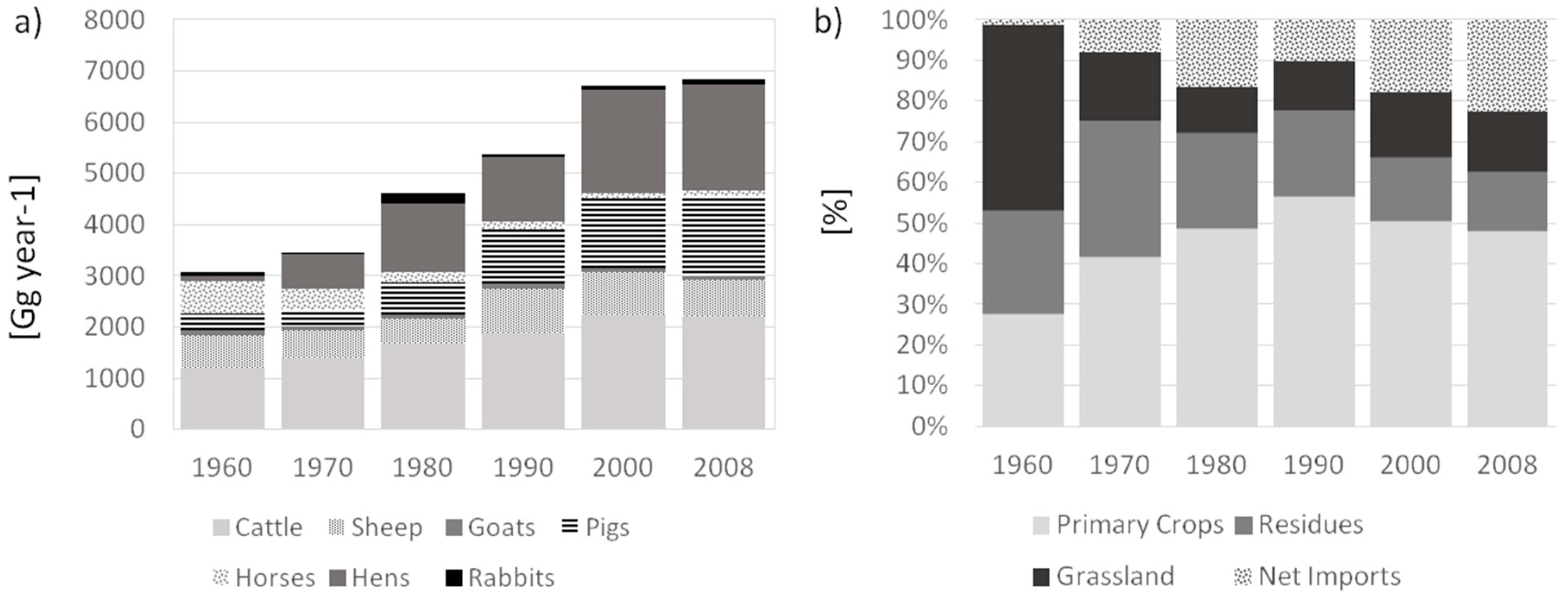
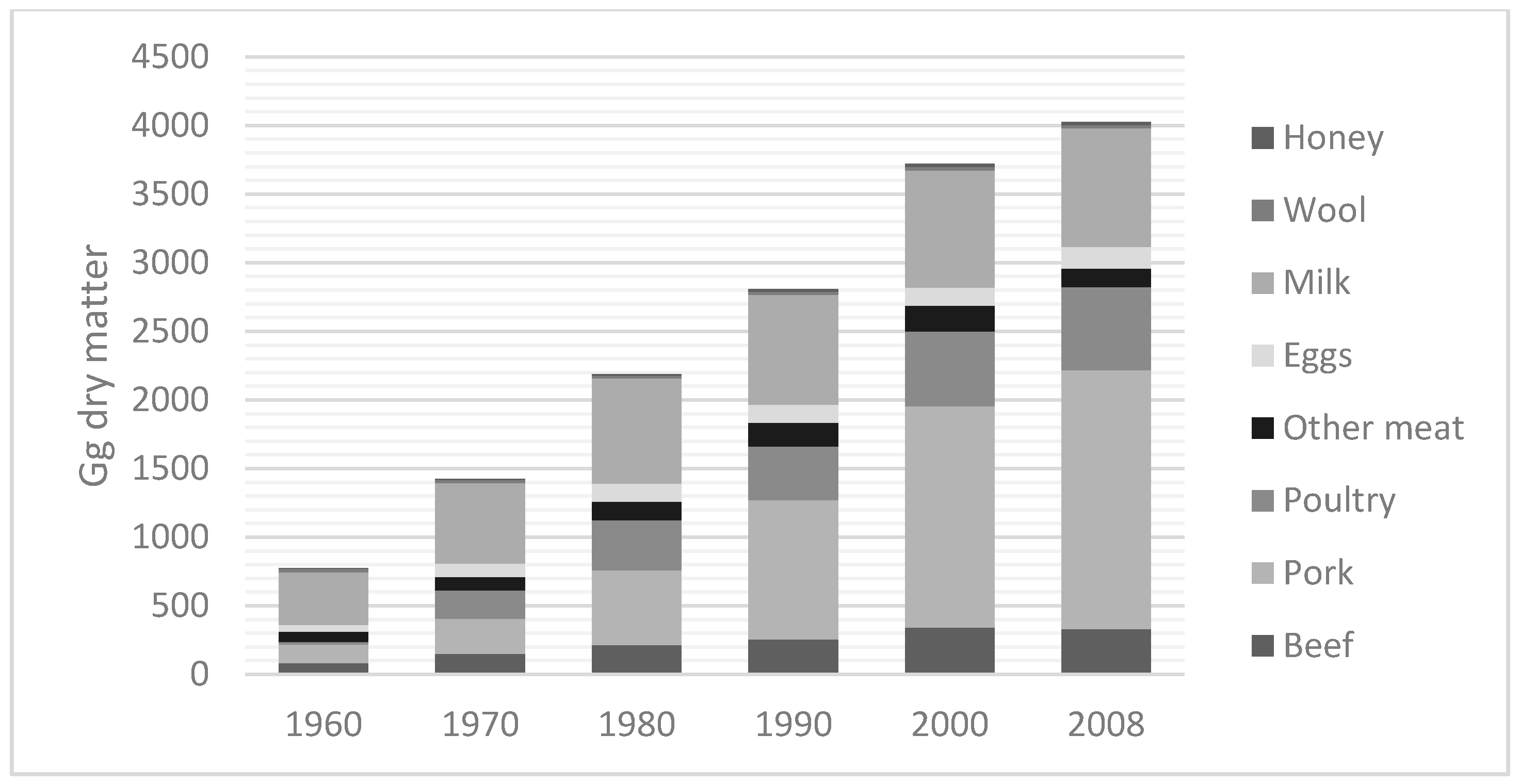
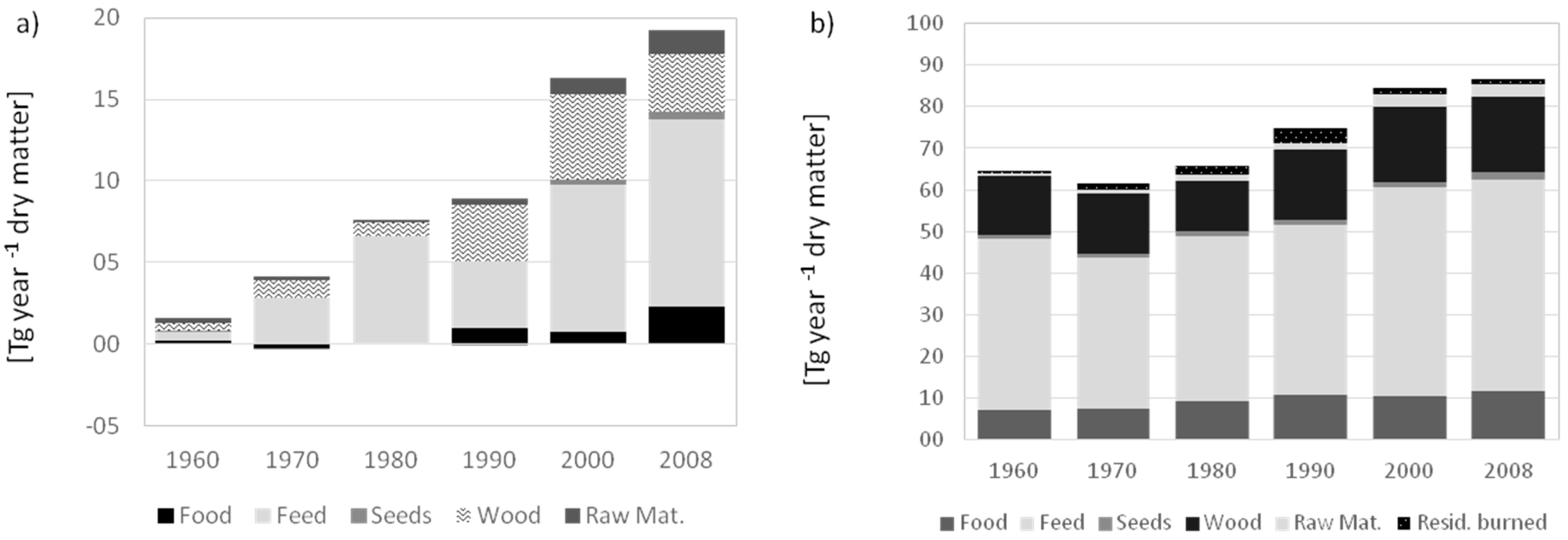
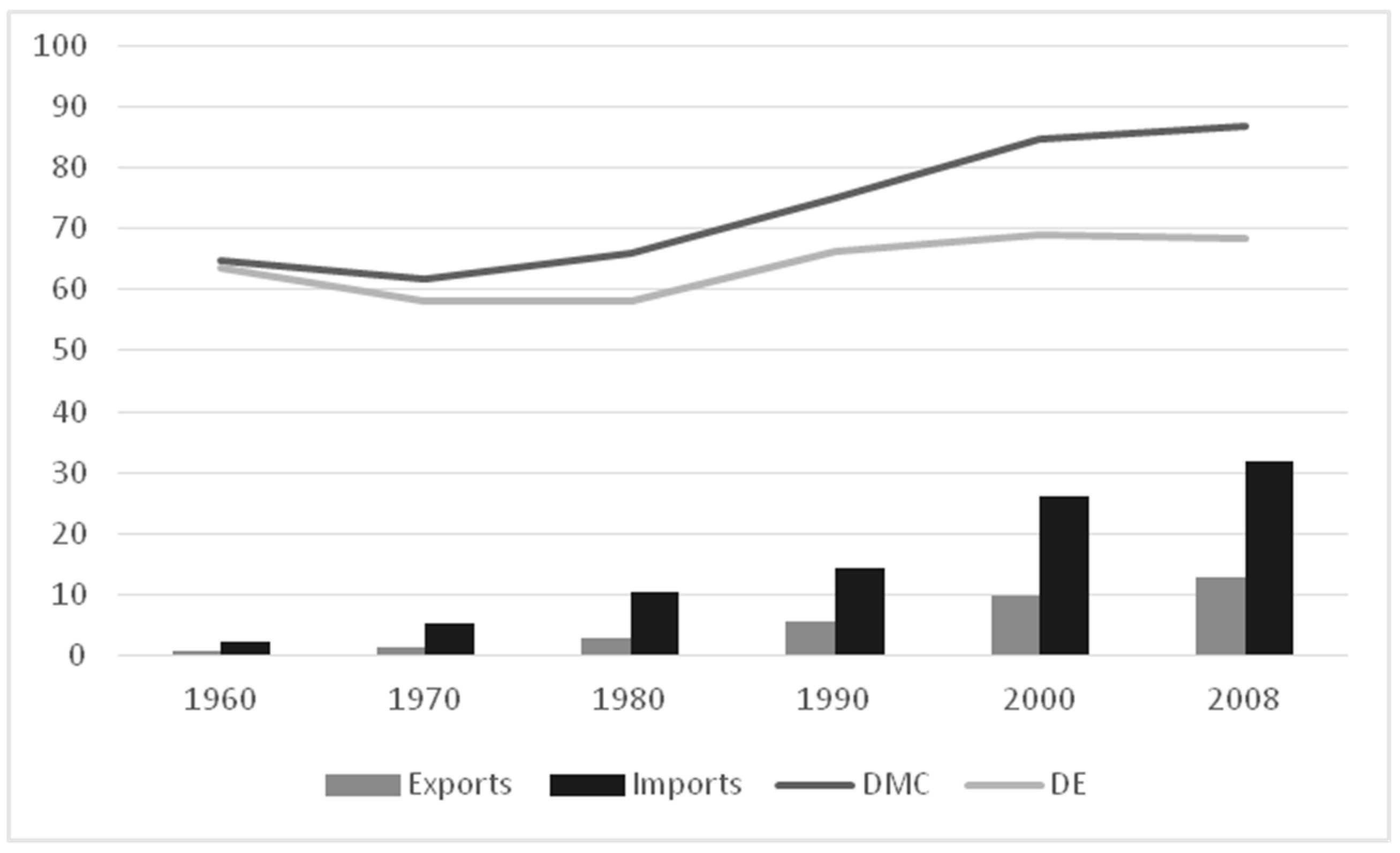
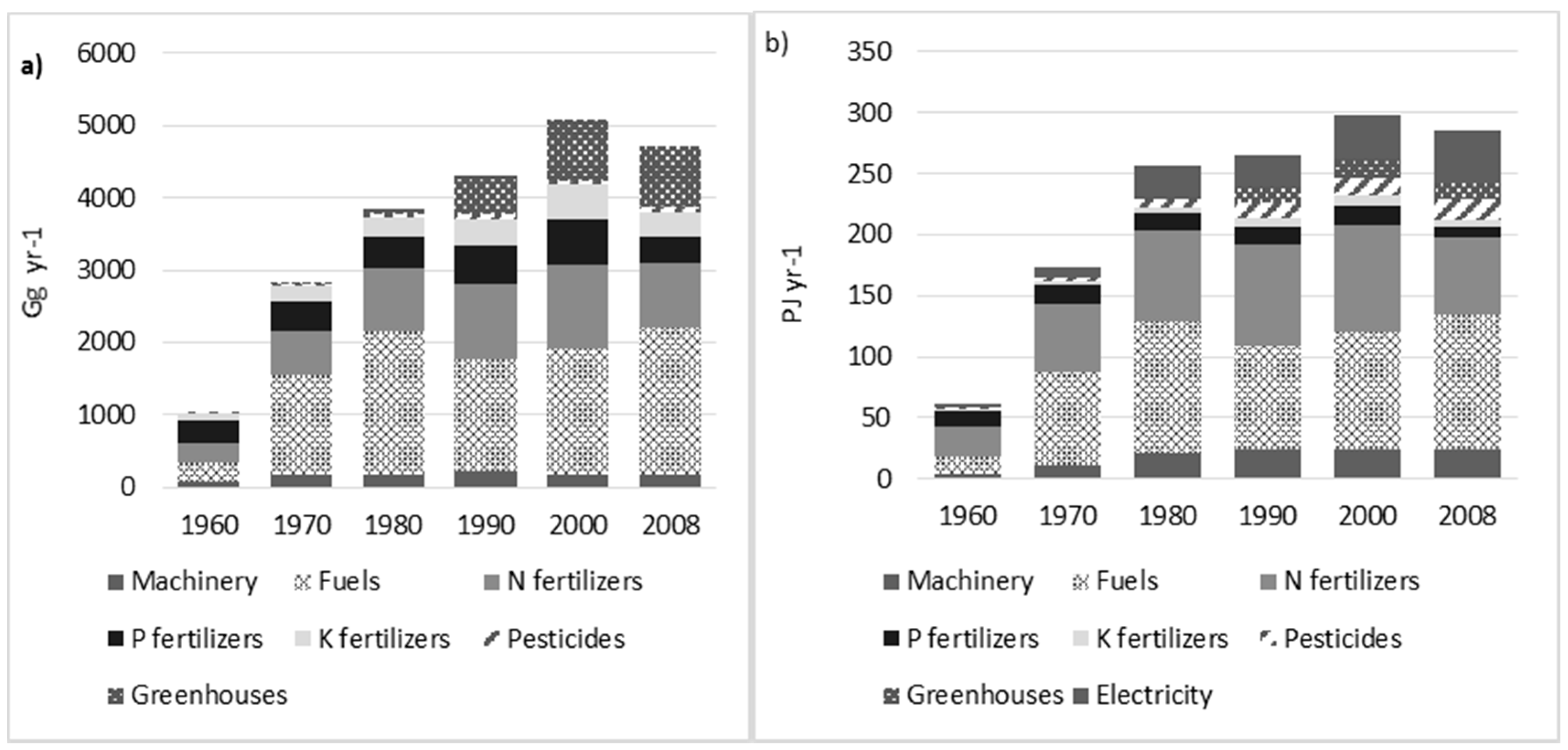
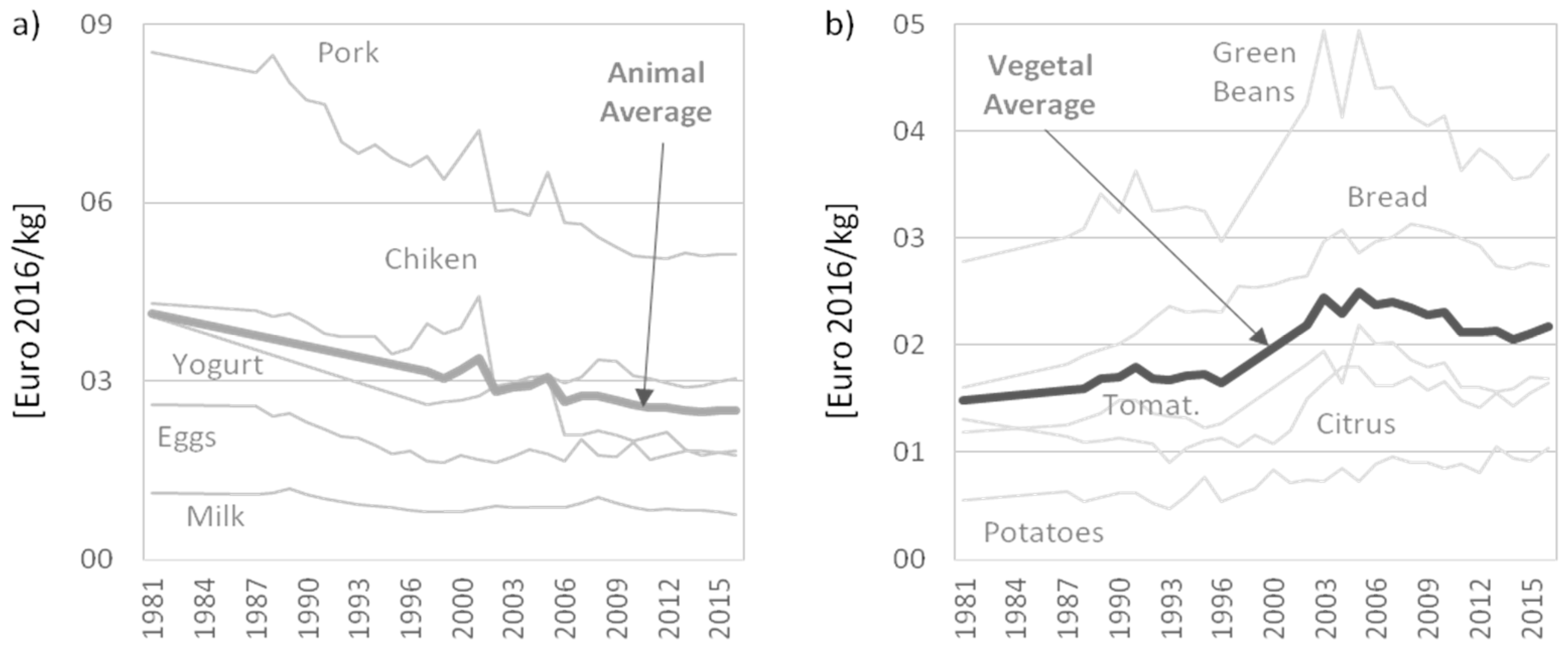
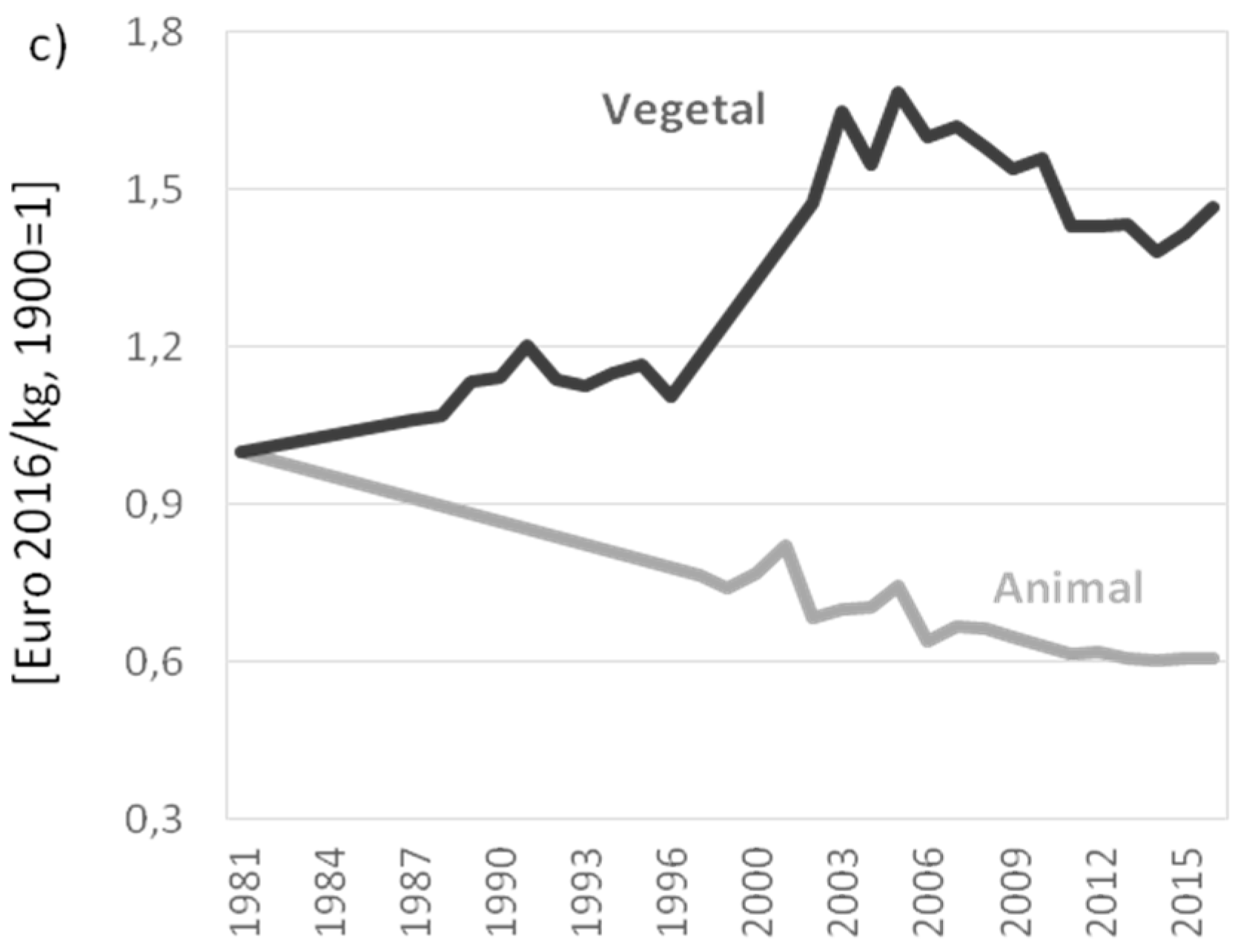
| 1960 | 1970 | 1980 | 1990 | 2000 | 2008 | |
|---|---|---|---|---|---|---|
| Cereals | 280 | 217 | 186 | 161 | 159 | 182 |
| Legumes | 36 | 34 | 18 | 17 | 12 | 16 |
| Roots and tubers | 287 | 264 | 256 | 236 | 161 | 131 |
| Vegetables | 281 | 292 | 306 | 407 | 377 | 344 |
| Fruit | 118 | 173 | 233 | 265 | 249 | 220 |
| Dried fruits and nuts | 8 | 6 | 11 | 7 | 8 | 9 |
| Oleaginous plants | 7 | 8 | 7 | 14 | 21 | 21 |
| Alcoholic drinks | 141 | 255 | 310 | 316 | 324 | 329 |
| Oil | 40 | 48 | 73 | 79 | 91 | 87 |
| Sugar | 59 | 83 | 63 | 71 | 80 | 70 |
| Meat + fat | 56 | 108 | 157 | 224 | 273 | 243 |
| Eggs | 15 | 27 | 32 | 32 | 28 | 25 |
| Dairy | 291 | 393 | 453 | 449 | 458 | 418 |
| Fish | 49 | 51 | 54 | 56 | 70 | 67 |
| Honey | 1 | 1 | 1 | 2 | 2 | 2 |
| Plant Biomass | 1257 | 1381 | 1466 | 1573 | 1482 | 1411 |
| Animal Biomass | 411 | 578 | 696 | 761 | 827 | 753 |
| Total | 1669 | 1960 | 2161 | 2334 | 2310 | 2164 |
| Plant Biomass | Animal Biomass | Total Biomass | ||||
| Year | Calories | % | Calories | % | Calories | % |
| 1960 | 2400 | 86.6 | 374 | 13.4 | 2774 | 100.0 |
| 1970 | 2406 | 81.7 | 538 | 18.3 | 2944 | 100.0 |
| 1980 | 2409 | 78.5 | 659 | 21.5 | 3069 | 100.0 |
| 1990 | 2398 | 74.6 | 816 | 25.4 | 3214 | 100.0 |
| 2000 | 2434 | 72.8 | 908 | 27.2 | 3342 | 100.0 |
| 2008 | 2401 | 74.1 | 841 | 25.9 | 3242 | 100.0 |
| Proteins * | ||||||
| Plant Biomass | Animal Biomass | Total Biomass | ||||
| Year | G | % | g | % | g | % |
| 1960 | 49 | 64 | 27 | 36 | 76 | 100.0 |
| 1970 | 43 | 52 | 39 | 48 | 82 | 100.0 |
| 1980 | 36 | 43 | 48 | 57 | 84 | 100.0 |
| 1990 | 35 | 39 | 55 | 61 | 90 | 100.0 |
| 2000 | 31 | 33 | 62 | 67 | 93 | 100.0 |
| 2008 | 32 | 36 | 57 | 64 | 89 | 100.0 |
| Carbohydrates | |||||||
| Year | Plant | Animal | Total | kcal | % * | ||
| g | % | g | % | g | |||
| 1960 | 390 | 96 | 15 | 4 | 405 | 1620 | 58.4 |
| 1970 | 365 | 95 | 20 | 5 | 385 | 1540 | 52.3 |
| 1980 | 315 | 93 | 23 | 7 | 338 | 1352 | 44.1 |
| 1990 | 306 | 93 | 23 | 7 | 330 | 1320 | 41.1 |
| 2000 | 291 | 92 | 24 | 8 | 315 | 1260 | 37.7 |
| 2008 | 296 | 93 | 22 | 7 | 318 | 1272 | 39.2 |
| Lipids | |||||||
| Year | Plant | Animal | Total | kcal | % * | ||
| g | % | g | % | g | |||
| 1960 | 53 | 69 | 23 | 30 | 77 | 693 | 25.0 |
| 1970 | 61 | 64 | 34 | 36 | 95 | 855 | 29.0 |
| 1980 | 85 | 67 | 42 | 33 | 127 | 1143 | 37.2 |
| 1990 | 91 | 63 | 55 | 38 | 146 | 1314 | 40.9 |
| 2000 | 104 | 63 | 60 | 36 | 165 | 1485 | 44.4 |
| 2008 | 100 | 64 | 56 | 36 | 156 | 1404 | 43.3 |
| Area, in Thousands of Hectares | ||||||
| Land uses | 1960 | 1970 | 1980 | 1990 | 2000 | 2008 |
| Crop land | 20,413 | 20,885 | 20,499 | 20,172 | 18,304 | 17,271 |
| High Forest | 4929 | 6240 | 6741 | 7189 | 7460 | 8307 |
| Coppice | 5076 | 4640 | 4824 | 4979 | 5055 | 5146 |
| Open Forest (Dehesa) | 3320 | 3835 | 4033 | 3636 | 3893 | 4342 |
| Pasture and scrubland | 12,594 | 11,190 | 10,691 | 10,746 | 11,645 | 11,294 |
| Non-productive | 4169 | 3710 | 3712 | 3777 | 4143 | 4139 |
| Total | 50,500 | 50,500 | 50,500 | 50,500 | 50,500 | 50,500 |
| Actual Net Primary Productivity (NPPact) in Gg of Dry Matter per Year | ||||||
| Accumulated biomass | 16,999 | 21,683 | 25,437 | 23,447 | 24,362 | 23,661 |
| Unharvested biomass | 187,468 | 203,534 | 196,652 | 202,860 | 217,449 | 222,057 |
| Reutilized biomass (1) | 41,899 | 35,839 | 36,581 | 41,335 | 43,583 | 41,891 |
| Socialized biomass (2) | 21,597 | 22,233 | 21,541 | 24,920 | 25,300 | 26,592 |
| Domestic extraction (1 + 2) | 63,496 | 58,072 | 58,122 | 66,255 | 68,883 | 68,483 |
| Total NPPact | 267,962 | 283,288 | 280,211 | 292,561 | 310,694 | 314,201 |
| 1960 | 1970 | 1980 | 1990 | 2000 | 2008 | |
|---|---|---|---|---|---|---|
| Primary Crops | ||||||
| Cereals | 7556 | 10,674 | 13,110 | 16,543 | 18,632 | 20,191 |
| Leguminous Vegetables | 674 | 607 | 342 | 226 | 296 | 207 |
| Vineyards | 765 | 1192 | 1774 | 1551 | 1786 | 1572 |
| Olive groves | 1050 | 1117 | 1400 | 1578 | 2820 | 3377 |
| Vegetables and tubers | 1434 | 1679 | 1911 | 2061 | 1636 | 1407 |
| Fruit trees | 1094 | 1146 | 1358 | 1576 | 1704 | 1773 |
| Industrial Crops | 1300 | 1902 | 2437 | 3520 | 3249 | 2359 |
| Forage | 6078 | 6496 | 8464 | 8521 | 8532 | 6660 |
| Total | 19,950 | 24,813 | 30,795 | 35,575 | 38,655 | 37,547 |
| Residues | ||||||
| Cereals | 9530 | 11,346 | 8755 | 8332 | 7502 | 7243 |
| Leguminous vegetables | 769 | 685 | 332 | 163 | 128 | 068 |
| Vineyards | 1624 | 2093 | 2239 | 2054 | 1524 | 1777 |
| Olive groves | 1480 | 2024 | 1869 | 1716 | 1654 | 1648 |
| Vegetables and tubers | 127 | 168 | 190 | 234 | 213 | 193 |
| Fruit trees | 1327 | 1589 | 1803 | 2094 | 2220 | 1995 |
| Burned by-products | 561 | 1541 | 2282 | 3622 | 1437 | 1255 |
| Total | 15,417 | 19,446 | 17,471 | 18,214 | 14,678 | 14,179 |
| Pasture and forest | ||||||
| Grazed biomass | 18,837 | 6099 | 4613 | 4883 | 8093 | 7596 |
| Wood | 2399 | 4671 | 4135 | 6543 | 6333 | 8160 |
| Timber from forests | 6893 | 3042 | 1108 | 1040 | 1123 | 1001 |
| Total Domestic Extraction | 63,496 | 58,071 | 58,122 | 66,255 | 68,882 | 68,483 |
| Biomass | 1960 | 1970 | 1980 | 1990 | 2000 | 2008 |
|---|---|---|---|---|---|---|
| Food | 7108 | 7979 | 9277 | 9960 | 9865 | 9418 |
| Feed | 40,480 | 33,201 | 33,200 | 36,553 | 41,134 | 39,367 |
| Seeds | 858 | 1097 | 1098 | 1159 | 1012 | 1269 |
| Wood and fuel wood | 13,723 | 13,420 | 11,155 | 13,446 | 12,854 | 14,581 |
| Raw materials | 766 | 834 | 1110 | 1514 | 2581 | 2592 |
| By-products burned | 561 | 1541 | 2282 | 3622 | 1437 | 1255 |
| Total | 63,496 | 58,071 | 58,122 | 66,255 | 68,882 | 68,483 |
© 2017 by the authors. Licensee MDPI, Basel, Switzerland. This article is an open access article distributed under the terms and conditions of the Creative Commons Attribution (CC BY) license (http://creativecommons.org/licenses/by/4.0/).
Share and Cite
González de Molina, M.; Soto Fernández, D.; Infante-Amate, J.; Aguilera, E.; Vila Traver, J.; Guzmán, G.I. Decoupling Food from Land: The Evolution of Spanish Agriculture from 1960 to 2010. Sustainability 2017, 9, 2348. https://doi.org/10.3390/su9122348
González de Molina M, Soto Fernández D, Infante-Amate J, Aguilera E, Vila Traver J, Guzmán GI. Decoupling Food from Land: The Evolution of Spanish Agriculture from 1960 to 2010. Sustainability. 2017; 9(12):2348. https://doi.org/10.3390/su9122348
Chicago/Turabian StyleGonzález de Molina, Manuel, David Soto Fernández, Juan Infante-Amate, Eduardo Aguilera, Jaime Vila Traver, and Gloria I. Guzmán. 2017. "Decoupling Food from Land: The Evolution of Spanish Agriculture from 1960 to 2010" Sustainability 9, no. 12: 2348. https://doi.org/10.3390/su9122348
APA StyleGonzález de Molina, M., Soto Fernández, D., Infante-Amate, J., Aguilera, E., Vila Traver, J., & Guzmán, G. I. (2017). Decoupling Food from Land: The Evolution of Spanish Agriculture from 1960 to 2010. Sustainability, 9(12), 2348. https://doi.org/10.3390/su9122348






